Abstract
Plastic has transformed the world; however, it generates a huge amount of waste plastics. It is well evident that, if urgent action is not undertaken on plastic pollution, it will pose threats to not only the environment, but also human life. Just simply discarding waste plastics will result in wasting a lot of valuable materials that could be recycled. Recently, the use of waste plastics has been considered for producing wood plastic composites (WPCs), which are superior to normal wood. Waste plastics are pelletized using an extruder and are then subjected to injection molding. In this study, investigations were carried out to determine the possibility of producing WPCs without the palletization of waste plastic to turn WPC production into a shorter, simple, and easy-to-achieve process. Here, a waste milk bottle, a familiar single-use plastic, was picked as a case study. Waste plastic granules and wood particles were mixed and directly injection molded to produce valuable WPCs. The water absorption of WPCs with 20% wood is 0.35%, and this increased to 0.37% when wood content was increased to 40%. The tensile strength at yield, elongation at break, and impact strength of WPCs with 20% wood content are 19.54 MPa, 5.21%, and 33.92 KJ/m2, respectively, whereas it was 17.23 MPa, 4.05%, and 26.61 KJ/m2 for the WPCs with 40% wood content. This process can be a potential solution for two problematic wastes at the same time.
1. Introduction
Every minute, a considerable quantity of waste is generated from different sources, which makes it a worldwide problem. The disposal of waste has attracted a lot of attention because the consequences on human health and the environment are already evident.
Plastics are one of the most widely used materials. In general, plastics are large-sized molecular chains made by repeated similar and smaller units (called monomers) and are now one of the most widespread and essential components of modern life [1]. The colossal scale of plastics’ use is a phenomenon less than a century old because of its incredible properties, such as being lightweight, durable, versatile, and inexpensive [2]. Hundreds of different types of plastic products are available, and new variations with unique properties are continuously being developed. Plastics are gradually being used as a substitute for other conventional materials, such as, for instance, pottery, metals, glass, wood, etc., on a broader level [3]. Plastics have a wide range of applications starting from bottles to tanks, toys to furniture, pens to computers, clothes to vehicles, etc., thus making the measurement of its versatility nearly impossible. As demand for plastic products surges, many industries manufacture it or use it in their products to satisfy needs. Global plastic manufacturing is increasing at approximately 8.6% per year (PlasticsEurope 2016). It is estimated that world plastic manufacturing will rise to 0.85 billion tons by 2050 [1].
Unfortunately, the intrinsic qualities that make plastics unique, such as its sturdiness and lightweight nature, are the same qualities that make its disposal problematic. Plastics are generally non-biodegradable; while some plastics are biodegradable, the amount biodegraded is actually very small, and/or it degrades very slow [4]. The lifetime of waste plastics is highly variable and depends on its chemical nature and the characteristics of the environment where it is being disposed of. The increasing use of plastic products simply elevates the number of plastics ending up as waste. In many cases, plastics are used only once, especially as shopping bags, packaging, and food containers. Plastics are increasingly found in the environment and water systems. Along with other consumer products, waste plastics contribute to the growth in municipal waste. In most countries, available landfill sites are now becoming restricted in terms of how much they can take. Excessive quantities of waste plastics are not disposed of properly, ended up in landfill, or, in some countries, burned to remove from premises. The burning of plastics causes toxic emissions which are bad for both direct contact when exposed and via indirect contact when rain carries those toxins into our waters and soil. In these ways, waste plastics are generating great risks to life forms and the environment. Therefore, it is important to develop an appropriate waste plastics management technology and infrastructure which is economically viable and easy to operate and achieve. Management systems for waste plastics are, regrettably, not being established as fast as the manufacture of plastics. Consequently, waste plastics have now garnered considerable attention from the media, policymakers, activists, and scientists. Numerous strategies such as reuse, recycling, and resource recovery have been studied to assess the utilization of waste plastics. Recycling is considered to be the most effective, consistent, and economical management technology for waste plastics [5]. The inherent properties of plastics make them recyclable at several different levels. Recycling is not only a disposal method of waste plastics, but also a valid technique to reduce the necessity of virgin plastics for product manufacturing, which would mean less consumption of non-renewable resources [6].
Wood plastic composites (WPCs) are a form of composite combining wood-based materials with plastics. From a functional point of view, a WPC is moisture-resistant and deterioration-resistant, which means WPCs will remain integrally and aesthetically better than typical wood. Moreover, WPCs are more heat-resistant than normal lumber, making a product that can be applied in positions where ordinary lumber may warp or twist. Virgin plastics are widely used to produce WPCs. Products made from waste plastics for this use are increasing. In recent times, the use of waste plastics has been considered for producing WPCs. Waste plastic is a promising raw material source for WPCs because of the large volume and low cost of these materials. Reutilizing the post-consumed polymeric materials reduces the environmental impact and the consumption of virgin plastics [7].
Injection molding is broadly used in the plastic industry to produce parts that have complex geometries and necessitating no finishing step [8]. In the past few years, several research studies have been carried out on the production of WPCs using injection molding [9,10,11,12,13,14,15,16,17]. Gosselin et al. [9] produced fiber-reinforced microcellular foams via injection molding. The compounding of the polymer, wood, and coupling agent was performed on a co-rotating, twin-screw extruder. Kuo et al. [11] investigated the effects of material compositions on the mechanical properties of WPCs manufactured by injection molding. Pellets from virgin low-density polyethylene (LDPE), polypropylene (PP), and acrylonitrile-butadiene-styrene (ABS) and recycled polypropylene (PP) were used as the plastic matrices, which were sourced from several chemical industries. Sykacek et al. [10] also sourced four biodegradable polymers and non-degradable cellulosic plastic from different chemical companies and produced WPCs. Sommerhuber et al. [14] sourced waste PS and ABS from electronic and electrical equipment, which was later used in production. Turku et al. [15] utilized the lightweight quality of construction plastic waste and municipal plastic waste to prepare WPCs. Taufiq et al. [16] produced WPCs from recycled PP and PE blends and reinforced them with kenaf fiber. Lopez et al. [17] used sawdust from Cedrela odorata L. and recycled thermoplastics and calcium carbonate in the production of WPCs.
The above-mentioned researchers either used virgin plastic pellets or pelletized waste plastic using an extruder, as shown in Figure 1. In this study, investigations were carried out to determine the possibility of producing WPCs without the palletization of waste plastic to turn WPC production into a shorter, simple, and easy-to-achieve process.
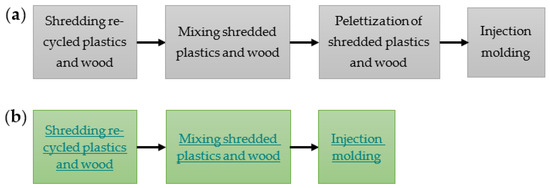
Figure 1.
Schematic of wood–plastic composite production through (a) traditional method and (b) the method studied in this research.
2. Materials and Methods
2.1. Materials and Sample Preparation
Here, a waste milk bottle, a well-known, single-use plastic, was used as plastic feedstock as a case study. Other hard plastics can be used as feedstock also. The sample waste milk bottles were collected from a café at UNSW Sydney. The labels and lids of the milk bottles were separated. The milk bottles were rinsed with water. Following this, the cleaned bottles were shredded to reduce the size suitable for injection molding using a shredder (SHINI, Stantonbury, UK) of 5 mm mesh. The milk bottle granules were dried in an oven (Labec, Marrickville, NSW, Australia) at 80 °C for 4 h.
Wood offcuts were collected from a local furniture producer. Wood was first shredded using a low-speed granulator (SHINI, UK) of 5 mm mesh and further pulverized using a knife mill (FRITSCH, Germany) with 1 mm mesh. The shredded wood was dried in an oven (Labec, Marrickville, NSW, Australia) at 80 °C for 24 h.
Two blends (20:80 and 40:60) were prepared by mixing specified percentages of the shredded milk bottle with wood (and 2% PP-g-MA). Polypropylene-graft-maleic anhydride (PP-g-MA), a coupling agent, was provided by Sigma–Aldrich (St. Louis, MO, USA).
The blends were molded using an injection molding machine (BOY 15 S, Neustadt, Germany) with a screw diameter of 22 mm, using the mold to make a dumbbell-shaped tensile test specimen (ASTM D638; type I; 165 mm × 19 mm × 4 mm) and a square-shaped impact test specimen (ASTM D6110; 127 mm × 12.7 mm × 4 mm). The injection molding parameters are the following: feed, compression, and metering zone temperatures: 150, 165, and 180 °C, respectively; mold temperature 20 °C; injection pressure 100 MPa; cooling time was 15 s because Fourier transform infrared spectroscopy (FTIR) and X-ray diffraction (XRD) confirm that the milk bottle is made of HDPE polymer, as reported in Figure 2.
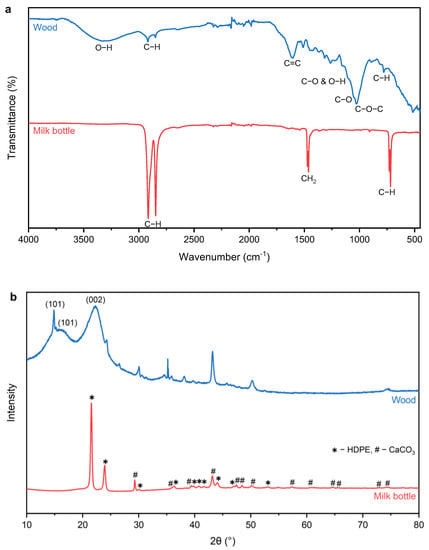
Figure 2.
(a) Fourier transform infrared spectroscopy (FTIR) and (b) X-ray diffraction (XRD) of raw materials used in this study.
The pictures of prepared injection-molded samples in this study are presented in Table 1. Each sample is designated by identity to avoid confusion in the discussion.

Table 1.
The prepared injection-molded samples in this study.
2.2. Characterization
Numerous characterizations have been carried out in this study. Each characterization was performed several times. Five successful tests were used for calculation.
FTIR is usually used for polymers to distinguish polymer type and the existence of other materials in the plastic [18]. The test was performed using a FTIR spectrometer (PerkinElmer, USA) with an attenuated total reflectance (ATR) accessory. FTIR spectra were acquired from 3000 cm−1 to 450 cm−1 at 4 cm−1 resolution and 32 scan summations. For each sample, spectra were obtained from different positions of a sample and averaged.
XRD is a characterization tool which is carried out to understand the structural feature of a sample. XRD analysis was accomplished by means of an X-ray diffractometer (PANalytical, The Netherlands) with Cu-Kα radiation at 45 kV and 40 mA over a 2θ range from 10° to 80° with a step size of 0.026° and step time of 500 s. HighScore Plus software was utilized for data analysis.
The tensile test is the most applied test to assess the performance of a sample in service. The tensile test of molded products was performed using a universal machine (5982, Instron, Norwood, MA, USA) with a laser extensometer (LX 500, MTS, Eden Prairie, USA) following ASTM D638 standard [19].
The impact test is carried out to determine the toughness of a sample. The impact test was performed using a Charpy impact tester (Toyoseiki, Tokyo, Japan) following ASTM D6110 standard [20].
The morphology of the wood sample was examined by a scanning electron microscope (SEM, S3400 Hitachi, Tokyo, Japan). Before performing SEM, the samples were coated with carbon to avoid overcharging.
The density of a sample is its quantity of mass per unit volume which was determined following ASTM D4892 standard [21]. The volume of a sample was measured using a gas pycnometer (AccuPyc II 1340, Micromeritics, Norcross, GA, USA), and mass was measured using a weighing scale (XS205, Mettler Toledo, Columbus, Ohio, USA).
The water absorption behavior of molded parts was investigated following ASTM D570 standard [22].
The particle size distribution of the shredded wood particles using a laser diffraction particle size analyzer (Mastersizer 3000, Malvern Panalytical, Malvern, UK).
3. Results and Discussion
The SEM image of the shredded wood sample is shown in Figure 3a. The wood sample is not homogenous in size; it has varying particle sizes from micrometer to millimeter. The particle size of the shredded wood sample ranges from micro to milli-meter. The particle size distribution of the pulverized wood measured by the laser diffraction particle size analyzer is reported in Figure 3b. These wood particles were incorporated with shredded milk bottles to create wood–plastic composites. The physical, mechanical, and chemical aspects of the prepared composites were assessed, and are discussed in the following subsections.
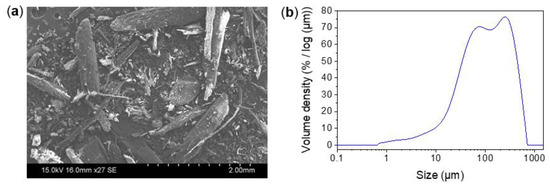
Figure 3.
The particle size distribution measurement of the pulverized wood: (a) scanning electron microscopy (SEM) and (b) laser diffraction particle size analysis.
3.1. FTIR Analysis
The FTIR spectra of the materials used in this study and injection-molded samples are presented in Figure 2a. For HDPE, two major overlapped peaks at ~2915 and ~2848 cm−1 are usually observed, which is due to the existence of C−H symmetric and asymmetric stretching vibrations. Another two overlapping peaks at ~1472 and ~1462 cm−1 are linked to CH2-bending vibrations. The additional two overlapped peaks at ~730 and ~718 cm−1 were assigned to CH2-rocking vibrations. Similar peaks were observed for milk bottles, which clearly indicates that the collected milk bottle is produced from HDPE polymer.
The FTIR spectrum of the wood sample, as depicted in Figure 2a, has a strong wide peak between 3500 and 3100 cm−1, which was assigned to OH stretching vibrations. This band is caused by the presence of alcoholic and phenolic hydroxyl groups involved in hydrogen bonds. Peaks at 2920 and 2850 cm−1 to C–H stretching vibrations of the methoxyl group. Absorption bands located around 1605, 1510, and 1450–1420 cm−1 are related to vibrations of aromatic rings (C=C) present in the wood. An intense band at 1026 cm−1 is assigned to the deformation vibrations of the C–H bonds in the quaiacyl ring and deformation vibrations of the C–O bonds. Peaks at 890, 815, and 780 cm−1 are caused by the deformation vibrations of C–H bonds in the aromatic ring.
The molded WPC was analyzed by means of FTIR to determine if the reprocessing affects the quality of the polymer. From the results reported in Figure 4a, it is clear that the injection-molded samples retain the original properties of the initial materials.

Figure 4.
Normalized (a) FTIR spectra and (b) XRD patterns of the samples.
3.2. XRD Analysis
The XRD pattern of the collected milk bottle is shown in Figure 2b. The XRD analysis of the milk bottle confirmed that it contains about 25% calcium carbonate (CaCO3)—a frequently used additive—and that the rest is HDPE polymer. The XRD patterns of the wood used in this study and wood–plastic composite samples are provided in Figure 4b. It is seen that there is no significant difference between initial materials and injection-molded samples in terms of composition.
3.3. Density
Table 2 presents the density of the injection-molded parts. The density of the molded parts from plastic milk bottles is 0.948 g/cm3. It is obvious from Table 2 that the density increased as the wood-to-HDPE ratio increased. The density soared from 0.948 g/cm3 to 0.978 g/cm3 as the wood-to-milk bottle ratio increased from 0 to 0.2. The further addition of wood increased density in the same way.

Table 2.
The density and water absorption behavior of injection-molded parts.
3.4. Water Resistance
The results from the water absorption analysis are reported in Table 2, and suggest that insignificant water absorption occurred for the prepared wood–plastic composites. The observed water absorption is due to the water absorbed by the wood particles. The water absorption rate increased with an increase in wood content because wood is porous and hydrophilic. The water absorption increased from 0.35% to 0.37% when wood particle content was increased from 20 percent to 40 percent. However, the water absorption is not significant for both WPCs containing 20 percent and 40 percent wood. According to [23], water absorption in polymer composites can occur in three different ways:
- Water molecules can diffuse within the microvoids and pores between the polymer chains;
- Capillary transport can occur in gaps and faults at the interfaces between fiber and matrix;
- Swelling effects can propagate microcracks in the matrix.
3.5. Tensile Properties
The tensile test results of the injection-molded wood–plastic composites were illustrated in Figure 5a,b. Tensile strength at yield was decreased when wood particles are introduced with the shredded milk bottle. The wood particles may act as fillers, leading to a decrease in tensile strength. The higher the amount of wood particles, the less the tensile strength. The tensile strength at yield for the sample with 40% wood content is 17.23 MPa.
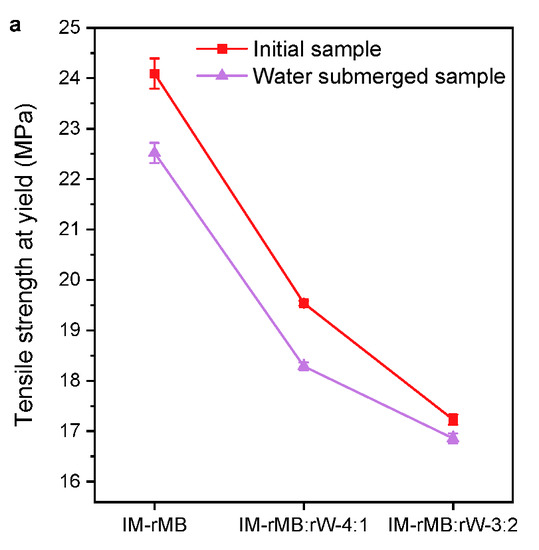
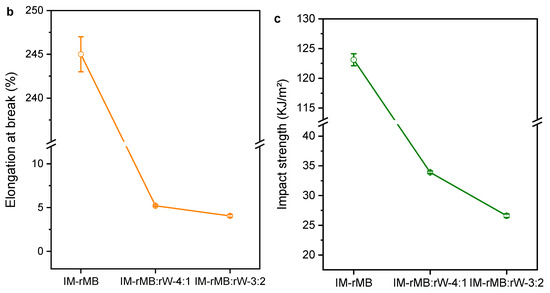
Figure 5.
(a,b) Tensile and (c) impact properties of injection-molded wood–plastic composites.
In addition, tensile testing was performed for water-submerged samples. The difference in tensile strength between initial and water-submerged samples is highlighted in Figure 5a. The reason for the slight decrease in the tensile strength at yield between the initial and water-absorbed samples is due to the water absorption, as reported in Table 2. The tensile strength of the IM-rMB:rW-3:2 sample was not decreased as much as the IM-rMB:rW-4:1 sample because of the smaller amount of water absorption. These results suggest that the properties of the samples will not change if they are subject to an aquatic environment.
A significant change was observed for the elongation at break, as can be seen in Figure 5b. The elongation at break was decreased because the incorporation of wood particles reduced adhesive bonding between polymers [24]. The elongation at break for the sample with 40% wood content is 4.05%.
The obtained results show that the WPC from this simple and less-step process has good mechanical properties that can be used in various applications.
3.6. Impact Properties
The results of the impact test of the wood–plastic composite samples are presented in Figure 5c. The incorporation of wood particles tended to decline the impact strength of the milk bottle sample, which is similar to the results of Huang and Zhang [25]. The impact strength was reduced to 33.9 KJ/m2 from 123.1 KJ/m2 when 20% wood was introduced. The impact strength for the sample with 40% wood content is 26.61 KJ/m2. The results suggest that the WPC has good impact resistance.
3.7. Fracture Surface Examination
The obtained pictures for the crack propagation zone of fracture surfaces are given in Figure 6. Variation in fracture surface morphology was noticed at high magnification. As can be observed from the figures, the facture surface of the milk bottle is ductile, involving stretched fibrils. CaCO3 acts as a reinforcement for HDPE, which significantly increases the impact toughness [26]. The fracture surface morphology is in good agreement with the impact strength reported in Figure 5. Moreover, Figure 6 shows that, as the wood-to-milk bottle ratio increased, the fracture surface became more brittle-like.

Figure 6.
Scanning electron microscopy (SEM) of the impact test fracture surface of the injection-molded parts.
Overall, although the value of tensile and impact properties was decreased for wood-plastic composites compared to recycled milk bottles, it is close to the tensile strength of molded parts using virgin HDPE, which indicated that the wood–plastic composites prepared through this process can be used to manufacture high-quality products.
4. Conclusions
In this study, a shorter, simple, and easy-to-achieve process has been demonstrated to utilize waste hard plastics as feedstock to produce WPCs. In this study, a waste milk bottle, a familiar single-use plastic, was chosen as a case study; however, other hard waste plastics can be used as feedstock. Collected milk bottles were cleaned with water, dried, and shredded to make granules. Afterward, the granules were mixed with wood particles and directly injection-molded to produce WPCs. The molded parts were characterized through FTIR, XRD, density, water absorption, tensile testing, and impact testing. The water absorption of the WPC with 20% wood was 0.35%, which increased to 0.37% when wood content was increased to 40%. It is clear from the results that the mechanical properties of prepared WPCs are good. The tensile strength at yield, elongation at break, and impact strength of the WPC with 20% wood content are 19.54 MPa, 5.21%, and 33.92 KJ/m2 respectively, whereas it was 17.23 MPa, 4.05%, and 26.61 KJ/m2 for the WPC with 40% wood content. This study shows that the WPC from the shorter process can be used in various applications. This process can be a potential solution for two problematic wastes at the same time. Thus, locally accrued waste can be transformed through small scale production with minimal steps and required facilities into high-value products that can be used locally.
Author Contributions
M.S.N.-A.-T.: Conceptualization, Methodology, Investigation, Formal analysis, Visualization, Writing—original draft, Writing—review and editing. F.P.: Conceptualization, Methodology, Validation, Supervision, Writing—review and editing. V.S.: Conceptualization, Resources, Supervision, Funding acquisition, Project administration, Writing—review and editing. All authors have read and agreed to the published version of the manuscript.
Funding
This research was cooperated under ARC Research Hub for Microrecycling of Battery and Consumer Wastes (IH190100009).
Data Availability Statement
The datasets generated and analyzed during the current study are not publicly available but are available from the corresponding author on reasonable request.
Acknowledgments
We gratefully acknowledge the technical support provided by Bill Joe, George Yang and Irshad Mansuri. We would also like to acknowledge the facilities and the scientific and technical assistance of the Electron Microscope Unit (EMU), ICP Laboratory, Spectroscopy Laboratory, X-ray Diffraction Laboratory and X-ray Fluorescence Laboratory within the Mark Wainwright Analytical Centre (MWAC) at UNSW Sydney.
Conflicts of Interest
The authors declare no conflict of interest.
References
- Hunt, E.J.; Zhang, C.; Anzalone, N.; Pearce, J.M. Polymer recycling codes for distributed manufacturing with 3-D printers. Resour. Conserv. Recycl. 2015, 97, 24–30. [Google Scholar] [CrossRef]
- Seppala, J. Plastics–the good, the bad and the ugly? Express Polym. Lett. 2018, 12, 855. [Google Scholar] [CrossRef]
- Wong, S.; Ngadi, N.; Abdullah, T.; Inuwa, I. Current state and future prospects of plastic waste as source of fuel: A review. Renew. Sustain. Energy Rev. 2015, 50, 1167–1180. [Google Scholar] [CrossRef]
- Andrady, A.L. Plastics and the Environment; John Wiley & Sons: Hoboken, NJ, USA, 2003. [Google Scholar]
- Zia, K.M.; Bhatti, H.N.; Bhatti, I.A. Methods for polyurethane and polyurethane composites, recycling and recovery: A review. React. Funct. Polym. 2007, 67, 675–692. [Google Scholar] [CrossRef]
- Wu, G.; Li, J.; Xu, Z. Triboelectrostatic separation for granular plastic waste recycling: A review. Waste Manag. 2013, 33, 585–597. [Google Scholar] [CrossRef]
- Najafi, S.K. Use of recycled plastics in wood plastic composites—A review. Waste Manag. 2013, 33, 1898–1905. [Google Scholar] [CrossRef]
- Gardner, D.J.; Han, Y.; Wang, L. Wood-Plastic Composite Technology. Curr. For. Rep. 2015, 1, 139–150. [Google Scholar] [CrossRef] [Green Version]
- Gosselin, R.; Rodrigue, D.; Riedl, B. Injection Molding of Postconsumer Wood-Plastic Composites I: Morphology. J. Thermoplast. Compos. Mater. 2006, 19, 639–657. [Google Scholar] [CrossRef]
- Sykacek, E.; Hrabalova, M.; Frech, H.; Mundigler, N. Extrusion of five biopolymers reinforced with increasing wood flour concentration on a production machine, injection moulding and mechanical performance. Compos. Part A Appl. Sci. Manuf. 2009, 40, 1272–1282. [Google Scholar] [CrossRef]
- Kuo, P.-Y.; Wang, S.-Y.; Chen, J.-H.; Hsueh, H.-C.; Tsai, M.-J. Effects of material compositions on the mechanical properties of wood–plastic composites manufactured by injection molding. Mater. Des. 2009, 30, 3489–3496. [Google Scholar] [CrossRef]
- Schirp, A.; Mannheim, M.; Plinke, B. Influence of refiner fibre quality and fibre modification treatments on properties of injection-moulded beech wood-plastic composites. Compos. Part A Appl. Sci. Manuf. 2014, 61, 245–257. [Google Scholar] [CrossRef]
- Dolza, C.; Fages, E.; Gonga, E.; Gomez-Caturla, J.; Balart, R.; Quiles-Carrillo, L. Development and Characterization of Environmentally Friendly Wood Plastic Composites from Biobased Polyethylene and Short Natural Fibers Processed by Injection Moulding. Polymers 2021, 13, 1692. [Google Scholar] [CrossRef] [PubMed]
- Sommerhuber, P.F.; Wang, T.; Krause, A. Wood-plastic composites as potential applications of recycled plastics of electronic waste and recycled particleboard. J. Clean. Prod. 2016, 121, 176–185. [Google Scholar] [CrossRef]
- Turku, I.; Keskisaari, A.; Kärki, T.; Puurtinen, A.; Marttila, P. Characterization of wood plastic composites manufactured from recycled plastic blends. Compos. Struct. 2017, 161, 469–476. [Google Scholar] [CrossRef]
- Taufiq, M.; Mansor, M.R.; Mustafa, Z. Characterisation of wood plastic composite manufactured from kenaf fibre reinforced recycled-unused plastic blend. Compos. Struct. 2018, 189, 510–515. [Google Scholar] [CrossRef]
- Lopez, Y.M.; Paes, J.B.; Gustave, D.; Gonçalves, F.G.; Méndez, F.C.; Nantet, A.C.T. Production of wood-plastic composites using cedrela odorata sawdust waste and recycled thermoplastics mixture from post-consumer products-A sustainable approach for cleaner production in Cuba. J. Clean. Prod. 2020, 244, 118723. [Google Scholar] [CrossRef]
- Veerasingam, S.; Ranjani, M.; Venkatachalapathy, R.; Bagaev, A.; Mukhanov, V.; Litvinyuk, D.; Mugilarasan, M.; Gurumoorthi, K.; Guga-nathan, L.; Aboobacker, V.M.; et al. Contributions of Fourier transform infrared spectroscopy in microplastic pollution research: A review. Crit. Rev. Environ. Sci. Technol. 2020, 51, 2681–2743. [Google Scholar] [CrossRef]
- ASTM International. D638-14; Standard Test Method for Tensile Properties of Plastics. ASTM International: West Conshohocken, PA, USA, 2014. [Google Scholar] [CrossRef]
- ASTM International. D6110-18; Standard Test Method for Determining the Charpy Impact Resistance of Notched Specimens of Plastics. ASTM International: West Conshohocken, PA, USA, 2018. [Google Scholar] [CrossRef]
- ASTM International. D4892-14(2019)E1; Standard Test Method for Density of Solid Pitch (Helium Pycnometer Method). ASTM International: West Conshohocken, PA, USA, 2019. [Google Scholar] [CrossRef]
- ASTM International. D570-98; Standard Test Method for Water Absorption of Plastics. ASTM International: West Conshohocken, PA, USA, 2018. [Google Scholar] [CrossRef]
- Alomayri, T.; Assaedi, H.; Shaikh, F.; Low, I. Effect of water absorption on the mechanical properties of cotton fabric-reinforced geopolymer composites. J. Asian Ceram. Soc. 2014, 2, 223–230. [Google Scholar] [CrossRef] [Green Version]
- Chaharmahali, M.; Tajvidi, M.; Najafi, S.K. Mechanical properties of wood plastic composite panels made from waste fiberboard and particleboard. Polym. Compos. 2008, 29, 606–610. [Google Scholar] [CrossRef]
- Huang, H.-X.; Zhang, J.-J. Effects of filler-filler and polymer-filler interactions on rheological and mechanical properties of HDPE-wood composites. J. Appl. Polym. Sci. 2009, 111, 2806–2812. [Google Scholar] [CrossRef]
- Tanniru, M.; Misra, R. On enhanced impact strength of calcium carbonate-reinforced high-density polyethylene composites. Mater. Sci. Eng. A 2005, 405, 178–193. [Google Scholar] [CrossRef]
Publisher’s Note: MDPI stays neutral with regard to jurisdictional claims in published maps and institutional affiliations. |
© 2022 by the authors. Licensee MDPI, Basel, Switzerland. This article is an open access article distributed under the terms and conditions of the Creative Commons Attribution (CC BY) license (https://creativecommons.org/licenses/by/4.0/).


